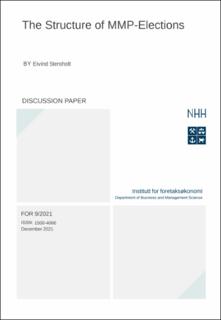| dc.description.abstract | In MMP-elections (Mixed Member Proportional representation), a QP-ballot contains a first-vote for party Q’s candidate in a single-seat constituency and a second-vote for a list of candidates from party P in one common tally. In split ballots P≠Q.
Traditional accounting does not record the ballot’s combination of first- and second-vote; collecting them in separate ballot boxes will not change the result. In the case of Bundestag elections, the assembly size is out of control, with 111 (136) extra-ordinary list seats in 2017 (2021).
Faithful accounting makes use of these combinations to stabilize the assembly size at some given norm (598 seats in the Bundestag), while still complying with MMP’s proportionality rule.
The Federal Constitutional Court emphasizes the principle of all voters’ equal influence on the result. In 2017 and 2021 split QP-ballots often gave full support to two winners, but QQ-ballots only to one (Q=CSU). If two ballots are from the same constituency, faithful accounting, gives them equal influence.
Under traditional accounting, a fusion of the sister parties CDU/CSU to one party “C*U” would reduce the size to 667 (598) seats in 2017 (2021). | en_US |
